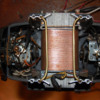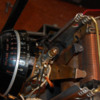I don't think you can NOT pull 30A from a PW-ZW under any reasonable condition safely.
Your double negatives are throwing me. Together, they mean you think you can safely pull 30 amps from a PW-ZW. Tain't so.
A PW-ZW is rated 275 watts (not continuously). The faceplate max voltage is 20. This works out to 13.75 amps. Old Lionel recommendation was don't exceed 75% of this continuously. That's 10.3 amp. I submit that this is the maximum that the secondary windings can carry continuously without overheating. If you set the output to 6 volts, that does not increase the carrying capacity of the secondary winding. While the transformer itself may stay cool, the bit of secondary winding between the end and the roller will get overly hot if this is exceeded.
Popi, I have wired up several homes n the family. You'll have to excuse me if I lack the confidence in the "professional" electricians. One of my sons bought a new townhouse from the builder. A GFI in the kitchen was wired backwards, so it did not protect receptacles downstream. A second son bought a used home. We renovated the kitchen. After being driven almost nuts, I found the electrician was feeding the kitchen outlets from each end of the string, from a different 20-amp breaker on the same side of the line. A third son, whose hot tub I had 220-volt wired many years ago, had his house renovated. The renovator's electrician altered the wiring to the hot tub, using thinner cable, and caused the motor to burn out. I submit that the average electrician has no idea what's in a ZW. Having done this task, it calls more for mechanical skill than electrical.
I agree with David re oiling the rollers. Oil is generally an insulator, and his point about it carbonizing is well-taken.







